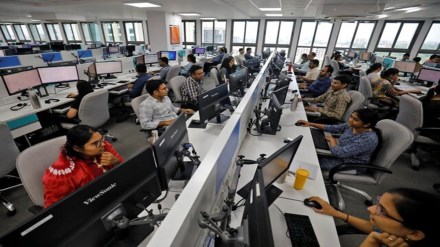By Sumita Dawra
In India, the Periodic Labour Force Survey (PLFS) captures employment trends across age, gender, education for rural and urban populations on quarterly and annual bases. Its launch in 2017 was a key government reform. Pre-2017, the National Sample Survey Office used to conduct employment and unemployment rounds quinquennially, leading to estimates with significant time lag. The PLFS offers more frequent and granular data, supporting evidence-based policy-making.
Broad employment trends: Based on PLFS data, employment in India broadly shows an improving trend 2017-18 onwards in indicators like labour force participation rate (LFPR), worker population ratio (WPR), and unemployment rate (UR) for people aged 15 years and above. For instance, the LFPR has increased from 49.8% in 2017-18 to 60.1% in 2023-24. Similarly, the WPR has increased from 46.8% in 2017-18 to 58.2% in 2023-24, and unemployment rate has declined from 6.0% to a low of 3.2%.
Rise of female workforce: The most important aspect of employment growth has been the rise of women workforce. Facilitated by government schemes, women have taken up self-employment and entered the workforce in an impressive scale. Data shows female WPR almost doubled from 22% to over 40% and UR dropped from about 6% to around 3% between 2017-18 and 2023-24.
We see an upward trend of educated women in the workforce. Around 40% of those with educational qualifications of post-graduate and above were working in 2023-24, compared to around 35% in 2017-18. About 24% of women with education up to higher secondary were in the workforce in 2023-24, compared to about 11% in 2017-18. Besides, around 50% of the women educated up to primary level were working in 2023-24, compared to about 25% in 2017-18.
PLFS methodology: The methodology adopted for the PLFS is based on global best practices; the US uses a similar survey methodology for capturing employment trends. PLFS estimates are widely used by agencies like the World Bank database and ILOSTAT.
Global comparisons: Based on ILOSTAT data, India’s UR is among the lowest compared to the average of 4.2% in 36 countries of Asia and the Pacific, 5.3% in 30 countries of Americas, and 5.7% in 51 countries of Europe and Central Asia.
Upward shift in self-employed: A noticeable trend in the PLFS data from 2017-18 to 2023-24 is an upward shift in self-employment. Data shows a decline in casual labour by about 5%, accompanied by a decline in regular wage/salary jobs at about 1%, with an upward shift in self-employed by about 6%. The shift is therefore attributable more to an increase in the total workforce and decline in low-quality casual labour employment, rather than a decline in the regular wage salaried workforce per se.
Self-employed are also employed: According to the 19th International Conference of Labour Statisticians, the International Labour Organization’s definition of employment is of people who “were engaged in any activity to produce goods or provide services for pay or profit”. This definition covers all forms of employment: employees, self-employed, family help (seen as contributing members), whether the employment is declared or not.
On the other hand, PLFS data includes self-employed, regular wage/salaried and casual labour. In this context, the PLFS also covers “helpers in household enterprise” under the self-employed category, as they are engaged in economic activity. About 37% of the female workforce in India fall in this category, and are categorised as employed.
Changing landscape: India has seen remarkable economic growth over the past decade, rising from the 10th largest economy in 2014 to the fifth largest in 2024, and transforming the employment landscape. Services, construction, trade, manufacturing and the micro, small and medium enterprise sector are the major drivers of employment growth, while the job market evolves rapidly. New roles are emerging in start-ups, gig economy, and key industries like healthcare, hospitality, and education. Both domestic and global markets are seeing a surge in opportunities, particularly in technology-driven roles. In this scenario, analytical thinking and creativity are among the most required skills.
Trends in employability: Studies such as India Skills Report 2024 show that the skill sets of our graduates have been catching up with growth trends and employability. Among graduates, employability shot up from 33.95% in 2013 to 54.81% in 2024. The QS World Future Skills Index 2025 shows India’s favourable position especially with respect to the “ready-to-recruit” market in digital roles, integrating artificial intelligence into the workforce, and green jobs. Emerging roles in smart manufacturing, logistics, hospitality and tourism, and healthcare are giving a fillip to the female workforce too.
Start-ups and GCCs: India has the world’s third-largest start-up ecosystem, with over 1.57 lakh department for promotion of industry and internal trade-registered firms directly employing 16.6 lakh people. India has become the GCC (global capability centre) capital of the world with the highest number of units after the US. Also, 17% of global technology capability centres have set up office in India. Around 1,700 GCCs operate in India, creating jobs particularly in healthcare and technology sectors. Nasscom, in its latest report, estimates that around 19 lakh jobs have been created in GCCs.
Education, skills, and employment: With a 51.25% employability rate of India’s youth (Economic Survey 2023-24), the future looks promising, especially with government’s focus on aligning education and skills with industry needs. By prioritising ease of doing business through visionary policy reforms, the government has paved the way for India to emerge as a prominent global manufacturing hub.
As India strides towards the vision of Viksit Bharat, empowering youth with the right skills and work experience, through schemes like the PM Internship and the employment-linked incentive, continues to be a priority.
The writer is secretary, ministry of labour and employment.
Disclaimer: Views expressed are personal and do not reflect the official position or policy of FinancialExpress.com. Reproducing this content without permission is prohibited.
